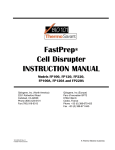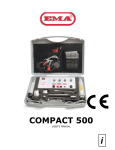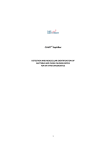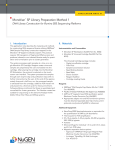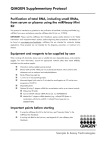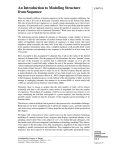Download FastRNA® Pro Blue Kit
Transcript
FastRNA® Pro Blue Kit Rapid Isolation of Total RNA from Gram Positive and Gram Negative Bacteria Using the FastPrep® Instrument Revision # 6025-050-3F24 FastRNA® Pro Blue Kit FastRNA® Pro Blue Kit Rapid Isolation of Total RNA from Gram Positive and Gram Negative Bacteria Using the FastPrep® Instrument Application Manual Revision # 6025-050-3F24 Catalog # 6025-050 50 Samples Storage temperature: Refrigerated or ambient temperature (4ºC or 15–30ºC) DO NOT expose RNApro™ Solution to light for extended periods of time. Store in the original bottle in the closed kit box. Note: An empty space in the box insert has been provided for convenient storage and access to the RNApro™ Solution when it has been removed from the safety shipping container. Any Questions? Call Technical Support at (800) 424-6101 3 FastRNA® Pro Blue Kit TABLE OF CONTENTS 1. Introduction to the FastRNA® Pro Blue Kit and the FastPrep® Instrument ...................5 2. 2.1 2.2 Kit Components and User Supplied Materials . . . . . . . . . . . . . . . . . . . . . . . . . .5 FastRNA® Pro Blue Kit Components.........................................................................5 User Supplied Materials ..........................................................................................6 3. Important Considerations before Use . . . . . . . . . . . . . . . . . . . . . . . . . . . . . . . . .6 4. Safety Precautions . . . . . . . . . . . . . . . . . . . . . . . . . . . . . . . . . . . . . . . . . . . . . . .7 5. Quick Protocol for Experienced Users . . . . . . . . . . . . . . . . . . . . . . . . . . . . . . . .7 6. Detailed Protocol . . . . . . . . . . . . . . . . . . . . . . . . . . . . . . . . . . . . . . . . . . . . . . . . .8 7. 7.1 7.2 7.3 7.4 7.5 Troubleshooting . . . . . . . . . . . . . . . . . . . . . . . . . . . . . . . . . . . . . . . . . . . . . . . . .11 Degraded RNA or Lower than Expected Yields........................................................11 No Pellet after Ethanol Precipitation.......................................................................12 Genomic DNA Contamination ................................................................................12 Mucopolysaccharide/Carbohydrate Contamination..................................................12 Lithium Chloride Precipitation................................................................................12 8. Recommended Reference Format for Publication . . . . . . . . . . . . . . . . . . . . . .13 9. References . . . . . . . . . . . . . . . . . . . . . . . . . . . . . . . . . . . . . . . . . . . . . . . . . . . .13 10. Related Products . . . . . . . . . . . . . . . . . . . . . . . . . . . . . . . . . . . . . . . . . . . . . . . .13 11. Product Use Limitation & Warranty . . . . . . . . . . . . . . . . . . . . . . . . . . . . . . . . . .14 4 visit us on the web at www.qbiogene.com FastRNA® Pro Blue Kit 1. Introduction to the FastRNA® Pro Blue Kit and the FastPrep® Instrument The FastRNA® Pro Blue Kit is a single reagent extraction method designed to quickly and efficiently isolate total cellular RNA from gram positive and gram negative bacteria. The RNApro™ Solution included in the kit is designed to efficiently inactivate cellular RNases during cell lysis to prevent RNA degradation. During use the RNApro™ Solution is mixed with the bacterial sample in a tube containing a specifically selected lysing matrix. The tube is then processed in the FastPrep® Instrument for 40 seconds to release the total cellular RNA, DNA and proteins. Following the FastPrep® homogenization the RNA is purified and isolated by chloroform extraction and ethanol precipitation. The purified RNA is ready for downstream applications, including RT-PCR and northern analysis. The average RNA yield from 1010 bacteria is greater than 50 µg. The FastPrep® Instrument is a high-speed, benchtop device that uses a proprietary vertical angular motion (1) to produce sample homogenization by simultaneous matrix impaction from multiple directions. The FastPrep® Instrument provides an extremely quick and highly reproducible homogenization that surpasses traditional lysis methods using enzyme digestion, sonication, blending, douncing and vortexing. When used with FastPrep® kits the FastPrep® Instrument permits the release and purification of intact DNA, RNA and proteins from virtually any source, including bacteria, yeast and fungi, spores, plant seeds and leaves, animal tissue, organs and blood, etc. 2. Kit Components and User Supplied Materials 2.1 FastRNA® Pro Blue Kit Components Product Description RNApro™ Solution DEPC-H2O Lysing Matrix B Short protocol User manual MSDS Certificate of Analysis Qty. 1 x 55 ml bottle 1 x 15 ml bottle 50 x 2 ml tubes 1 each 1 each 1 each 1 each Any Questions? Call Technical Support at (800) 424-6101 5 FastRNA® Pro Blue Kit 2.2 User Supplied Materials FastPrep® Instrument (Cat # 6001-100, -120, or -220) Microcentrifuge Pipettmen RNase Erase® (Cat # 2440-204), recommended Chloroform 100% ethanol 75% ethanol 1.5 or 2.0 ml RNase-free microcentrifuge tubes Agarose Gel loading dye and RNA size marker 3. Important Considerations before Use The presence or introduction of RNase during the procedure may result in sample degradation. It is strongly recommended that the user minimize the potential for RNase contamination by using gloves throughout the procedure, using DEPC-H2O and by treating pipettmen, work area, gel box and gel comb with RNase Erase®. Additional RNA handling methods and precautions may be found in references 2 and 3. The volume after the addition of RNApro™ Solution to the sample has been calculated to maintain a sufficient air space in the sample tube during FastPrep® Instrument processing. Sample loss or tube failure may result from overfilling the matrix tube. The matrix tube caps must be secure, but not over-tightened, to prevent sample leakage. If the sample is too large for processing in a single tube, divide the sample and process using multiple tubes. Confirm the sample tubes spin freely and will not scrape the microcentrifuge wall during centrifugation. The use of other manufactured tubes in the FastPrep® Instrument is not recommended and may result in sample loss or FastPrep® Instrument failure. Add the RNApro™ Solution to the sample as soon as possible to initiate RNase inhibition. Samples, both FastPrep® Instrument homogenized and non-homogenized, are stable in RNApro™ Solution overnight at room temperature or 4ºC. Bacterial strain variability may result in unwanted protein and mucopolysaccharide carryover into the aqueous solution following chloroform extraction. While this may not compromise downstream applications the user may adapt the protocol to include an additional chloroform (isoamyl alcohol may be included with the chloroform [CHCl3:IAA, 24:1, v:v]) extraction after Step 10 (Quick Protocol for Experienced Users) or in Step 12 (Detailed Procedure) to reduce the potential carryover. 6 visit us on the web at www.qbiogene.com FastRNA® Pro Blue Kit A single 40 second run at a speed setting of 6.0 in the FastPrep® Instrument is sufficient to lyse a bacterial sample. If the user determines that additional processing steps in the FastPrep® Instrument are required to homogenize a sample it is recommended that the sample be incubated on ice in the sample tube for at least 2 minutes between successive FastPrep® Instrument homogenizations to prevent sample heating and possible RNA degradation. The FastRNA® Pro Blue Kit is designed to selectively purify total cellular RNA from DNA and protein. Experiments have indicated the RNA is sufficiently pure for use in RT-PCR and northern analysis, however, it is recommended the user incorporate DNase I treatment of the RNA prior to use in applications where absolute control of DNA contamination is essential. Use DNase I at the concentration recommended by the manufacturer and incubate at 37ºC for 30 minutes. The DNase I is inactivated by incubation at 75ºC for 5 minutes or by addition of EDTA to 25 mM followed by phenol/chloroform extraction and precipitation (2, 3). 4. Safety Precautions The RNApro™ Solution contains components that when in contact with human tissue or during inhalation may cause irritation or burning. Wear personal protective equipment to prevent skin contact (e.g., gloves, lab coat, and eye protection) and prevent inhalation of reagent vapors and consumption of liquid during use. Consult the enclosed Material Safety Data Sheet for additional details. 5. Quick Protocol for Experienced Users 1. Dilute 1 ml of an overnight bacterial culture into 14 ml of fresh media in a sterile 50 ml tube and incubate for ~4–6 hours to reach an OD600 = 0.9–1.0. 2. Remove 10 ml of the culture to a 15 ml conical tube and pellet the cells by centrifugation. Decant the supernatant and add 1 ml of RNApro™ solution to the tube and resuspend the cells by pipetting or vortexing. 3. Transfer 1 ml of the bacterial solution mixture to a blue-cap tube containing Lysing Matrix B provided in the kit. 4. Process the tube in the FastPrep® Instrument for 40 seconds at a setting of 6.0. 5. Remove and centrifuge the tube at a minimum of 12,000 x g for 5 minutes at 4ºC. 6. Transfer the liquid (~750 µl) to a new microcentrifuge tube. Avoid transferring the debris pellet and lysing matrix. 7. Incubate the transferred sample 5 minutes at room temperature. Any Questions? Call Technical Support at (800) 424-6101 7 FastRNA® Pro Blue Kit 8. Add 300 µl of chloroform (NO isoamyl alcohol). Vortex 10 seconds and then incubate 5 minutes at room temperature. 9. Centrifuge the tubes at a minimum of 12,000 x g for 5 minutes at 4ºC. 10. Transfer the upper phase (without disturbing the interphase) to a new microcentrifuge tube. 11. Add 500 µl of cold absolute ethanol, invert 5X to mix and store at -20ºC for at least 30 minutes. 12. Centrifuge at a minimum of 12,000 x g for 15 minutes at 4ºC and remove the supernatant. 13. Wash the pellet with 500 µl of cold 75% ethanol (made with DEPC-H2O). 14. Remove the ethanol, air dry 5 minutes at room temperature (DO NOT completely dry the RNA) and resuspend the RNA in 100 µl of DEPC-H2O. 15. Incubate 5 minutes at room temperature. 16. Determine the RNA concentration: a. Dilute 5 µl of RNA into 495 µl of DEPC-H2O b. Read the OD260 using DEPC-H2O as a blank c. Calculate the sample µg RNA per ml using the formula: (OD260)(40 µg/ml/per OD)(100 [dilution factor]) = µg RNA per ml 17. Aliquot and store the RNA solution at -70ºC. 18. RNA integrity can be analyzed visually using denaturing or non-denaturing 1.2% agarose gel electrophoresis (See Figure 1) (2, 3). 6. Detailed Protocol 1. Dilute 1 ml of an overnight bacterial culture into 14 ml of fresh media in a sterile 50 ml tube or 250 ml flask. 2. Incubate for ~4–6 hours at 37ºC with shaking at ~150–200 rpm to reach an OD600 = 0.9–1.0 (Note: 1.0 OD600 for Escherichia coli is ~1 X 109 cells per milliliter). 3. Remove 10 ml of the culture to a 15 ml conical tube and pellet the cells by centrifugation at 2,800 rpm (x 1,500 g) for 15 minutes at 4ºC (e.g., Beckman Model TJ-6 Centrifuge, I-92 Swinging Bucket Rotor) for 10 minutes. 8 visit us on the web at www.qbiogene.com FastRNA® Pro Blue Kit 4. Decant the supernatant and add 1 ml of RNApro™ Solution to the tube. Completely resuspend the cells by pipetting or vortexing. 5. Transfer 1 ml of the resuspended cells to a blue-cap tube containing Lysing Matrix B provided in the kit. Securely close the cap to prevent leakage in the next step. NOTE: The calculated volumes will provide adequate airspace in the matrix tube to prevent sample leakage and/or tube failure. DO NOT overfill the matrix tube. To process a greater number of cells use a second matrix tube. 6. Process the sample tube in the FastPrep® Instrument for 40 seconds at a setting of 6.0. 7. Remove the sample tube and centrifuge at a minimum of 12,000 x g for 5 minutes at 4ºC or room temperature. 8. Transfer the liquid (~750 µl) to a new microcentrifuge tube. Avoid transferring the debris pellet and lysing matrix. 9. Incubate the transferred sample 5 minutes at room temperature to increase RNA yield. 10. Add 300 µl of chloroform (NO isoamyl alcohol). Vortex 10 seconds. 11. Incubate 5 minutes at room temperature to permit nucleoprotein dissociation and increase RNA purity. 12. Centrifuge the tubes at a minimum of 12,000 x g for 5 minutes at 4ºC. Samples containing large amounts of cellular mucopolysaccharides can be re-extracted with chloroform (isoamyl alcohol may be included with the chloroform [CHCl3:IAA, 24:1, v:v]) to increase RNA purity. Alternatively, a lithium chloride precipitation may be used (see the Troubleshooting section and references 3, 4). 13. Transfer the upper phase to a new microcentrifuge tube without disturbing the interphase. If a portion of the interphase is transferred, repeat the centrifugation with the upper phase, and transfer the new upper phase to a clean microcentrifuge tube. 14. Add 500 µl of cold absolute ethanol to the sample, invert 5X to mix and store at -20ºC for at least 30 minutes. 15. Centrifuge at a minimum of 12,000 x g for 15 minutes at 4ºC and remove the supernatant. The RNA will appear as a white pellet in the tube. If the pellet is floating the sample may be recentrifuged to place the pellet at the tube bottom. 16. Wash the pellet with 500 µl of cold 75% ethanol (made with DEPC-H2O). Any Questions? Call Technical Support at (800) 424-6101 9 FastRNA® Pro Blue Kit 17. Remove the ethanol, air dry 5 minutes at room temperature (DO NOT completely dry the RNA) and resuspend the RNA in 100 µl of DEPC-H2O for short-term storage. RNA is generally stable for up to a year at -80ºC. For longer term storage RNA samples may be stored at -20ºC as ethanol precipitates. When stored as an ethanol precipitate, the RNA must be precipitated and resuspended in aqueous solution prior to use. NOTE: RNA does not evenly distribute in ethanol and can lead to inconsistent RNA amounts between samples when equal volumes are pipetted. Vortex the RNA:ethanol solution to disperse the RNA prior to removing the sample. In situations where precise amounts of RNA are required it is best to precipitate the total amount (or excess) of RNA required, resuspend the RNA in DEPC-H2O and measure the concentration by OD260 before proceeding. 18. Incubate 5 minutes at room temperature to facilitate RNA resuspension. 19. Determine the RNA concentration: a. Dilute 5 µl of the purified RNA into 495 µl of DEPC-H2O b. Read the OD260 using DEPC-H2O as a blank c. Calculate the sample µg RNA per ml using the formula: (OD260)(40 µg/ml/per OD)(100 [dilution factor]) = µg RNA per ml Spectrophotometer accuracy is greatest between ~0.2 and ~0.8. If the OD reading is below the range, add more RNA sample (e.g., 20 µl RNA + 480 µl DEPC-H2O) or concentrate the RNA by precipitation and resuspension into a smaller volume. If the OD reading is above the recommended spectrophotometer range, use less RNA for the OD determination. 20. Aliquot and store the RNA solution at -70ºC. 21. The RNA integrity can be determined by analyzing a portion of the RNA sample using gel electrophoresis. Add 1 µg RNA in 9 µl DEPC-H2O, heat to 65ºC for 5 minutes, add gel loading buffer (see Related Products) and load the sample on a 1.2% agarose gel containing 2.2M formaldehyde in MOPS buffer. The sample is run at ~ 80 volts for 30 minutes (2, 3). Ethidium bromide may be added to the denatured RNA sample at a final concentration of 10 µg per milliliter prior to gel loading or the gel may be ethidium bromide stained and destained following electrophoresis and visualized under UV light. The quality of the RNA is determined by the appearance of the large, 23S, and small, 16S ribosomal RNAs as sharp, distinct bands of 2.9 and 1.5 kb. Heterogeneous-sized messenger RNA may appear as diffuse ethidium staining between and below the ribosomal bands. Small RNA species such as tRNA and 5S RNA may be present in varying amounts at the dye front. 10 visit us on the web at www.qbiogene.com FastRNA® Pro Blue Kit 1 2 3 4 5 Figure 1: Bacterial total RNA extracted with the FastRNA® Pro Blue Kit. Approximately 2% of the total RNA isolated from 1010 bacterial cells was loaded on to a 1.2% denaturing agarose gel (1XMOPS). Lane 1: Salmonella typhimurium; Lane 2: Pseudomonas stuartii; Lane 3: Escherichia coli; Lane 4: Bacillus subtilis; Lane 5: 0.24-9.5kb RNA Ladder. 7. Troubleshooting 7.1 Degraded RNA or Lower than Expected RNA Yields RNA purified using the FastRNA® Pro Blue Kit and analyzed by denaturing or non-denaturing agarose gel electrophoresis will appear as 2 distinct ribosomal RNA (rRNA) bands of approximately equal fluorescent intensity using ethidium bromide staining. The rRNA bands will appear in the area between 2000 and 1000 nucleotides. Messenger RNA (mRNA), which typically represents approximately less than 1% of the total cellular RNA and is heterogeneous length, will not be visible as distinct bands. rRNA is used as a marker to assess sample RNA degradation. Degraded RNA or mRNA may appear as unequal fluorescent intensity between bands, a single band may be completely lacking or a heterogeneous fluorescent smear may appear below the rRNA bands or throughout the gel lane. Recommended precautions include cleaning all instruments and work area with RNase Erase® (Qbiogene Catalog # 2440-204) prior to use. Use disposable sterile plastic containers when possible. Glassware should be thoroughly cleaned, rinsed with DEPC-H2O and baked at 250ºC for 4 hours to remove RNase. Sterile, plugged micropipettes are recommended (see 2, 3 for additional suggestions). Certain bacterial strains may contain elevated RNase levels. Reduce the exposure time to RNase by adding RNApro™ Solution to each sample as soon as possible following sample harvest. Process fewer samples to shorten the time before complete cellular lysis and exposure to the RNase inactivating activity of RNApro™ Solution. Bacteria in log phase growth with maximal aeration and nutrients provide the highest yield and integrity RNA. Bacterial cells in stationary phase, growing in oxygen or nutrient limiting conditions, stored for extended duration at room temperature or refrigerated for extended periods will contribute to reduced RNA yield and integrity. Any Questions? Call Technical Support at (800) 424-6101 11 FastRNA® Pro Blue Kit RNApro™ Solution can permeate samples and will protect bacterial RNA from degradation for at least 24 hours before it is processed in the FastPrep® Instrument. Artifactual RNA degradation may occasionally occur during gel electrophoresis due to a gel that was not RNase free, running the gel at too high voltage or from using depleted running buffer. Rerun the samples with a known intact RNA sample using freshly prepared reagents. RNA degradation may occur due to RNase contamination introduced into the DEPC-H2O following use. If contamination is suspected, prepare fresh DEPC-H2O in an RNase free container (2, 3). RNApro™ Solution contains RNase inactivating components and will not support active RNase contamination. 7.2 No Pellet after Ethanol Precipitation The purified RNA may not appear as a pellet but may instead adhere to the side of the tube. The RNA may not be visible and it MAY APPEAR THAT RNA HAS NOT BEEN PURIFIED. COMPLETE THE RNA PURIFICATION per the instructions provided and confirm the RNA concentration by OD260 and integrity by gel electrophoresis. RNA adhering to the tube wall will not affect its purity, size or use in subsequent applications. The RNA pellet may not be firmly attached to the side of the tube and may be observed floating in the solution or at the solution surface. Recentrifuge the sample in the same tube and exercise caution to not lose the pellet when removing the supernatant. Confirm enough sample was used to isolate RNA (1.0 OD for Escherichia coli ~1x109 cells). 7.3 Genomic DNA Contamination Genomic DNA contamination will appear as a high molecular weight smear on a denaturing gel or as ethidium bromide stained material in the gel loading well. In the event genomic DNA contamination occurs, treat sample with DNase according to the manufacturer’s instructions. 7.4 Mucopolysaccharide / Carbohydrate Contamination Samples containing large amounts of cellular mucopolysaccharides can be re-extracted after the initial chloroform extraction with a second chloroform extraction. Isoamyl alcohol may be included with the chloroform [CHCl3:IAA, 24:1, v:v]) to increase RNA purity. Refer also to Lithium Chloride Precipitation in the Troubleshooting section. 7.5 Lithium Chloride Precipitation Lithium chloride (LiCl) may be used to precipitate RNA while excluding carbohydrate, DNA and proteins, including transcription inhibitors. Lithium chloride has historically been used to precipitate RNA greater than ~300 nucleotides from tRNA and 5S RNA. Lithium chloride precipitation may be incorporated into the FastRNA® Pro Blue Kit procedure: Following ethanol precipitation of the RNA and resuspension in 100 µl 12 visit us on the web at www.qbiogene.com FastRNA® Pro Blue Kit DEPC-H2O, add lithium chloride to a final concentration of 2–3 M (e.g., 0.2 volumes [20 µl] RNase free 8 M lithium chloride). Add 2.5 volumes RNase free absolute ethanol (250 µl). Mix the solution and store on ice at least 2 hours. Centrifuge for 15 minutes at a minimum of 12,000 rpm at 4ºC. Remove the supernatant and wash the pellet with 75% cold RNase free ethanol. The ethanol wash step is critical to prevent LiCl inhibition of cell-free translation and in vitro transcription. Air dry and resuspend the RNA in 100 µl DEPC-H2O. 8. Recommended Reference Format for Publications Total RNA was isolated from _____ mg of _____cells using the FastRNA® Pro Blue Kit (Qbiogene, Inc., CA) and FastPrep® Instrument (Qbiogene, Inc, CA), for _____ seconds at a speed setting of _____. 9. References 1. 2. 3. U.S. Patent 5,567,050. Zbloninsky et.al, Apparatus and method for rapidly oscillating specimen vessels. Molecular Cloning, Sambrook and Russell. Cold Spring Harbor Laboratory Press, 3rd Edition, 2001. Current Protocols in Molecular Biology, John Wiley & Sons, Inc., 2002, www.currentprotocols.com. 10. Related Products Description FastPrep® FP100A Instrument FastPrep® FP120A Instrument FastPrep® FP220A Instrument FastRNA® Pro Red Kit (Yeast) FastRNA® Pro Green Kit (Plant & Animal) FastRNA® Pro Soil Kit FastDNA® Kit FastDNA® SPIN Kit for Soil FastPROTEIN™ Blue Matrix FastPROTEIN™ Red Matrix RNase Erase® Lysing Matrix B BGFNE (alkaline agarose gel loading dye) BBXFE (denaturing RNA gel loading dye) BBG (general purpose neutral gel RNA and DNA loading dye) BBG (general purpose neutral gel RNA and DNA loading dye) Any Questions? Call Technical Support at (800) 424-6101 Size 100V 120V 220V 50 preps 50 preps 50 preps 100 preps 50 preps 50 preps 50 preps 500 ml 50 x 2ml tubes 1 ml 1 ml 1 ml 1 ml Catalog # 6001-100 6001-120 6001-220 6035-050 6045-050 6070-050 6540-400 6560-200 6550-400 6550-600 2440-204 6911-050 2339-104 2343-104 2327-104 2327-104 13 FastRNA® Pro Blue Kit 11. Product Use Limitation & Warranty Unless otherwise indicated, this product is for research use only. Purchase of Qbiogene, Inc. products does not grant rights to reproduce, modify, or repackage the products or any derivative thereof to third parties. Qbiogene, Inc. makes no warranty of any kind, expressed or implied, including merchantability or fitness for any particular purpose, except that the products sold will meet our specifications at the time of delivery. Buyer’s exclusive remedy and the sole liability of Qbiogene, Inc. hereunder shall be limited to, at our discretion, no replacement or compensation, product credits, refund of the purchase price of, or the replacement of materials that do not meet our specification. By acceptance of the product, Buyer indemnifies and holds Qbiogene, Inc. harmless against, and assumes all liability for, the consequence of its use or misuse by the Buyer, its employees or others, including, but not limited to, the cost of handling. Said refund or replacement is conditioned on Buyer notifying Qbiogene, Inc. within thirty (30) days of receipt of product. Failure of Buyer to give said notice within thirty (30) days shall constitute a waiver by the Buyer of all claims hereunder with respect to said material(s). FastRNA®, FastDNA®, FastPrep® and BIO 101® Systems are registered trademarks of Qbiogene, Inc. RNApro™ is a trademark of Qbiogene, Inc. 14 visit us on the web at www.qbiogene.com






















